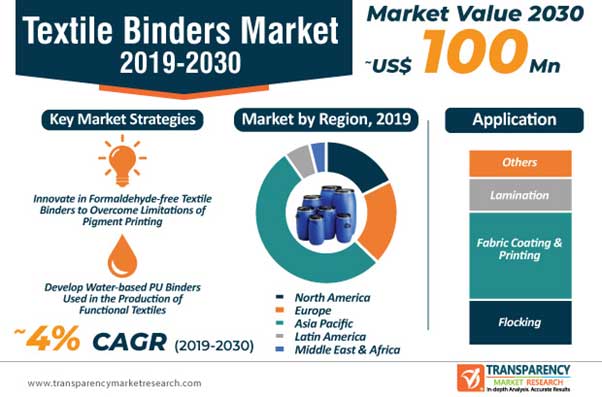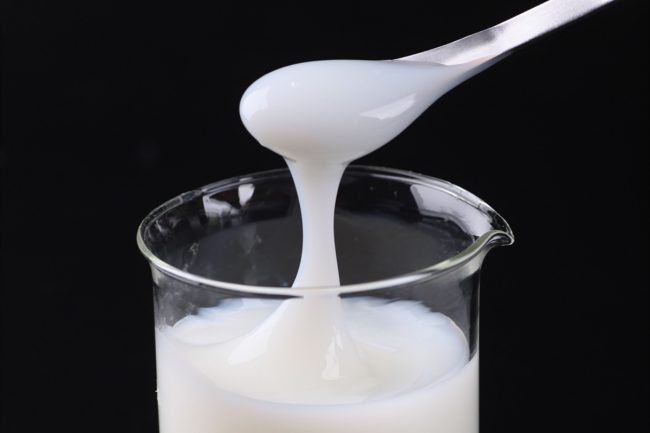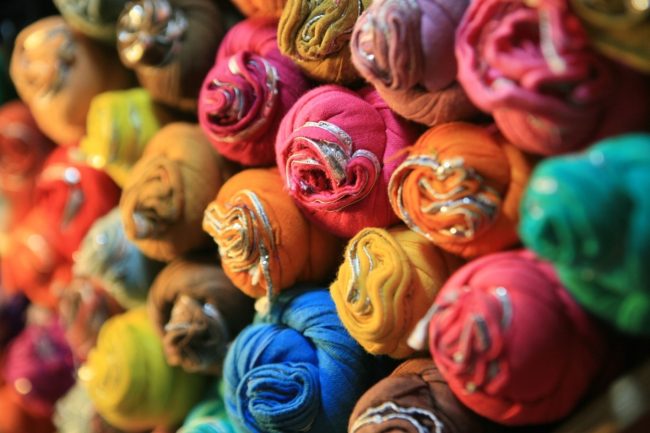
Innovations drive textile binders market
Expanding base of applications in end-use industries, such as apparel and sportswear, is driving the global demand for textile binders – the market for which is expected to reach $ 100 million by 2030, says Transparency Market Research.
Textile binders are used in printing paste to print several types of natural fibres such as silk, cotton, wool, and viscose due to their ability to react with chemicals in printing paste in order to bond colours to fibres after being steamed. Additionally, textile binders provide high wash fastness that enables colour retention even after washing. Pigment dyes are the independent type of fibres that are utilised to print on synthetic and natural fabrics. Additionally, these dyes are primarily utilised in traditional printing techniques, as the process is highly economical.

Growing printing market boosts demand
Textile printing is the process of applying colours to fabrics in definite patterns or designs. In properly printed fabrics, the colour is bonded to the fibre in order to resist washing and friction. Pigment colorant is a coloured organic substance that is not readily soluble in most common solvents and imparts coloration to textile substrates only when incorporated with an adequate binder system. Pigment binder is the latex polymer resin that forms a three-dimensional film on the surface of the fibre. This film contains dispersion of the textile pigment and helps adhere the pigment to the substrate surface. The permanence of this film is dependent on the polymer type and application conditions. The demand for textile binders is increasing, with new innovations and developments across the globe. Expanding base of applications in end-use industries, such as apparel and sportswear, is driving the demand for textile binders across the globe.
Textile binders market to reach valuation of approximately $ 100 million by 2030, according to Transparency Market Research. In terms of value, the global textile binders market is anticipated to expand at a CAGR of about 4% from 2020 to 2030.

Acrylic copolymer witnessing high demand
Based on material, the acrylic copolymer segment is projected to expand at a CAGR of more than 4% during the forecast period. Pigment printing agents are employed in large quantities, primarily in textiles with functional effects. The demand for textiles with innovative functional effects is high across the globe, due to the high adoption of modern materials among end users. This is likely to boost the lucrativeness of the acrylic copolymer segment during the forecast period.
The demand for pigment printing is primarily driven by rise in demand for modern apparel and clothing materials in the region. Thus, increase in the popularity of modern apparel and clothing materials; and growth in the production of textile products with new designs are projected to boost the acrylic copolymer segment of the textile binders market in Asia Pacific during the forecast period.
Fabric printing & coating drives demand
Based on application, the global textile binders market has been segregated into flocking, fabric coating & printing, lamination, and others. In terms of consumption, fabric coating & printing was the leading application segment of the global textile binders market in 2019. This trend is expected to continue in the near future. Fabric coating & printing is a major application of textiles binders in developed and developing countries. Textiles binders are employed in the production of apparel in the fabric coating & printing. This, in turn, is driving the demand for textile binders in apparel production. Flocking is anticipated to remain a lucrative segment of the global textile binders market during the forecast period. This can be ascribed to increase the adoption of flocking products in manufacturing of t-shirts, car glove boxes, packaging for perfumes, floor coverings, scrubbing pads, etc.
Asia Pacific to be lucrative region
In terms of consumption, Asia Pacific accounted for a dominant share of the global textile binders market in 2019, due to increase in the popularity of modern apparel and clothing materials in China, India, and countries in the ASEAN sub-region, where textile binders are used as intermediate raw materials in textile printing. Fabric coating & printing is a major application of textiles binders in developed and developing countries. Textiles binders are employed in the production of apparel in fabric coating & printing. This, in turn, is driving the demand for textile binders in apparel production. Flocking is anticipated to remain a lucrative application segment of the global textile binders market during the forecast period. This can be ascribed to increase in adoption of flocking products in manufacture of t-shirts, car glove boxes, packaging for perfumes, floor coverings, scrubbing pads, etc.

Competition landscape
The global textile binders market is highly fragmented. The top players such as Archroma Corporate, Fineotex Group, Dow, Camex Ltd, OMNOVA Solutions Inc, and Arkema SA cumulatively held more than 50% share of the global textile binders market in 2019. Key manufacturers operating in the global textile binders market are Organic Dyes And Pigments Llc, Pioneer Chemicals Inc, Scott Bader Company Ltd, Hemanjali Polymers Pvt Ltd, SETEX, and 3J Chemicals.
In terms of volume, Asia Pacific constituted significant share of the global textile binders market in 2019. Demand for textile binders in the region is anticipated to increase during the forecast period, due to rapid growth in the textile industry in Asia Pacific. The market in Asia Pacific is estimated to continue to expand at a rapid pace during the forecast period, owing to rise in demand for textile binders in various applications such as flocking, fabric printing, coating, and lamination in the region.
High demand for textile binders in Asia Pacific can also be ascribed to the presence of major textile producing countries in the region. Europe is another key region of the global textile binders market. However, stringent environment-related norms are likely to hamper the market in the region during the forecast period.
Eco-friendly ingredients in demand
Eco-friendly ingredients in textile binders are bolstering the credibility credentials of manufacturers in the market landscape. For instance, in May 2019, Archroma – a global colour and specialty chemicals company, Appretan NTR, an innovative water-based textile coating binder, which is formulated from renewable natural ingredients such as tea bags and coffee filters. Since the global textile industry is infamous for releasing pollutants into the environment during manufacturing processes, companies in the textile binders market are increasing their R&D muscle in natural ingredients.
Companies in the India textile binders market are under scrutiny for introducing natural ingredients in products. This is evident since Asia Pacific dictates the highest share among all regions in the textile binders market and the region’s revenue is projected for exponential growth during the forecast period. Hence, under the Indian Standards for Organic Textiles program, Indian textile manufacturers are limiting the use of synthetic binders in clothing and apparels.
Article Courtesy: Transparency Market Research (TMR)
About TMR:
Transparency Market Research is a market intelligence company that provides global business information reports and services. For details, contact email: sales@transparencymarketresearch.com



